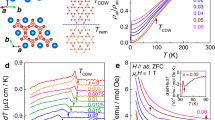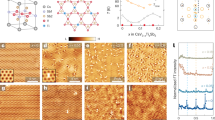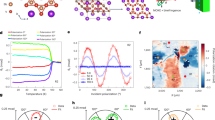Abstract
Electronic nematicity, in which rotational symmetry is spontaneously broken by electronic degrees of freedom, has been demonstrated as a ubiquitous phenomenon in correlated quantum fluids including high-temperature superconductors and quantum Hall systems1,2. Notably, the electronic nematicity in high-temperature superconductors exhibits an intriguing entanglement with superconductivity, generating complicated superconducting pairing and intertwined electronic orders. Recently, an unusual competition between superconductivity and a charge-density-wave (CDW) order has been found in the AV3Sb5 (A = K, Rb, Cs) family with two-dimensional vanadium kagome nets3,4,5,6,7,8. Whether these phenomena involve electronic nematicity is still unknown. Here we report evidence for the existence of electronic nematicity in CsV3Sb5, using a combination of elastoresistance measurements, nuclear magnetic resonance (NMR) and scanning tunnelling microscopy/spectroscopy (STM/S). The temperature-dependent elastoresistance coefficient (m11 minus m12) and NMR spectra demonstrate that, besides a C2 structural distortion of the 2a0 × 2a0 supercell owing to out-of-plane modulation, considerable nematic fluctuations emerge immediately below the CDW transition (approximately 94 kelvin) and finally a nematic transition occurs below about 35 kelvin. The STM experiment directly visualizes the C2-structure-pinned long-range nematic order below the nematic transition temperature, suggesting a novel nematicity described by a three-state Potts model. Our findings indicate an intrinsic electronic nematicity in the normal state of CsV3Sb5, which sets a new paradigm for revealing the role of electronic nematicity on pairing mechanism in unconventional superconductors.
This is a preview of subscription content, access via your institution
Access options
Access Nature and 54 other Nature Portfolio journals
Get Nature+, our best-value online-access subscription
$29.99 / 30 days
cancel any time
Subscribe to this journal
Receive 51 print issues and online access
$199.00 per year
only $3.90 per issue
Buy this article
- Purchase on Springer Link
- Instant access to full article PDF
Prices may be subject to local taxes which are calculated during checkout



Similar content being viewed by others
Code availability
The code used for STM data analysis is available from the corresponding author upon reasonable request.
Data availability
The data supporting the findings of this study are available from the corresponding author upon reasonable request. Source data are provided with this paper.
References
Fradkin, E., Kivelson, S., Lawler, M. J., Eisenstein, J. P. & Mackenzie, A. P. Nematic Fermi fluids in condensed matter physics. Annu. Rev. Condens. Matter Phys. 1, 153–178 (2010).
Fernandes, R. M., Orth, P. P. & Schmalian, J. Intertwined vestigial order in quantum materials: nematicity and beyond. Annu. Rev. Condens. Matter Phys. 10, 133–154 (2019).
Ortiz, B. R. et al. New kagome prototype materials: discovery of KV3Sb5, RbV3Sb5, and CsV3Sb5. Phys. Rev. Mater. 3, 094407 (2019).
Ortiz, B. R. et al. CsV3Sb5: a ℤ2 topological kagome metal with a superconducting ground state. Phys. Rev. Lett. 125, 247002 (2020).
Chen, K. Y. et al. Double superconducting dome and triple enhancement of Tc in the kagome superconductor CsV3Sb5 under high pressure. Phys. Rev. Lett. 126, 247001 (2021).
Yu, F. H. et al. Unusual competition of superconductivity and charge-density-wave state in a compressed topological kagome metal. Nat. Commun. 12, 3645 (2021).
Zhao, H. et al. Cascade of correlated electron states in the kagome superconductor CsV3Sb5. Nature 599, 216–221 (2021).
Chen, H. et al. Roton pair density wave in a strong-coupling kagome superconductor. Nature 599, 222–228 (2021).
Martin, I. & Batista, C. D. Itinerant electron-driven chiral magnetic ordering and spontaneous quantum Hall effect in triangular lattice models. Phys. Rev. Lett. 101, 156402 (2008).
Ko, W.-H., Lee, P. A. & Wen, X.-G. Doped kagome system as exotic superconductor. Phys. Rev. B 79, 214502 (2009).
Guo, H.-M. & Franz, M. Topological insulator on the kagome lattice. Phys. Rev. B 80, 113102 (2009).
Nandkishore, R., Levitov, L. S. & Chubukov, A. V. Chiral superconductivity from repulsive interactions in doped graphene. Nat. Phys. 8, 158–163 (2012).
Yu, S.-L. & Li, J.-X. Chiral superconducting phase and chiral spin-density-wave phase in a Hubbard model on the kagome lattice. Phys. Rev. B 85, 144402 (2012).
Kiesel, M. L., Platt, C. & Thomale, R. Unconventional Fermi surface instabilities in the kagome Hubbard model. Phys. Rev. Lett. 110, 126405 (2013).
Wang, W.-S., Li, Z.-Z., Xiang, Y.-Y. & Wang, Q.-H. Competing electronic orders on kagome lattices at van Hove filling. Phys. Rev. B 87, 115135 (2013).
Kang, M. et al. Twofold van Hove singularity and origin of charge order in topological kagome superconductor CsV3Sb5. Nat. Phys. https://doi.org/10.1038/s41567-021-01451-5 (2022).
Hu, Y. et al. Rich nature of Van Hove singularities in kagome superconductor CsV3Sb5. Preprint at https://arxiv.org/abs/2106.05922 (2021).
Jiang, Y.-X. et al. Unconventional chiral charge order in kagome superconductor KV3Sb5. Nat. Mater. 20, 1353–1357 (2021).
Liang, Z. et al. Three-dimensional charge density wave and surface-dependent vortex-core states in a kagome superconductor CsV3Sb5. Phys. Rev. X 11, 031026 (2021).
Li, H. et al. Observation of unconventional charge density wave without acoustic phonon anomaly in kagome superconductors AV3Sb5 (A = Rb, Cs). Phys. Rev. X 11, 031050 (2021).
Tan, H., Liu, Y., Wang, Z. & Yan, B. Charge density waves and electronic properties of superconducting kagome metals. Phys. Rev. Lett. 127, 046401 (2021).
Song, D. et al. Orbital ordering and fluctuations in a kagome superconductor CsV3Sb5. Sci. China-Phys. Mech. Astron. 65, 247462 (2022).
Feng, X., Jiang, K., Wang, Z. & Hu, J. Chiral flux phase in the kagome superconductor AV3Sb5. Sci. Bull. 66, 1384–1388 (2021).
Mielke, C. III et al. Time-reversal symmetry-breaking charge order in a correlated kagome superconductor. Nature 602, 245–250 (2022).
Yu, L. et al. Evidence of a hidden flux phase in the topological kagome metal CsV3Sb5. Preprint at https://arxiv.org/abs/2107.10714 (2021).
Yang, S.-Y. et al. Giant, unconventional anomalous Hall effect in the metallic frustrated magnet candidate, KV3Sb5. Sci. Adv. 6, eabb6003 (2020).
Yu, F. H. et al. Concurrence of anomalous Hall effect and charge density wave in a superconducting topological kagome metal. Phys. Rev. B 104, L041103 (2021).
Li, H. et al. Rotation symmetry breaking in the normal state of a kagome superconductor KV3Sb5. Nat. Phys. https://doi.org/10.1038/s41567-021-01479-7 (2022).
Xiang, Y. et al. Twofold symmetry of c-axis resistivity in topological kagome superconductor CsV3Sb5 with in-plane rotating magnetic field. Nat. Commun. 12, 6727 (2021).
Park, T., Ye, M. & Balents, L. Electronic instabilities of kagome metals: saddle points and Landau theory. Phys. Rev. B 104, 035142 (2021).
Christensen, M. H., Birol, T., Andersen, B. M. & Fernandes, R. M. Theory of the charge density wave in AV3Sb5 kagome metals. Phys. Rev. B 104, 214513 (2021).
Ortiz, B. R. et al. Fermi surface mapping and the nature of charge-density-wave order in the kagome superconductor CsV3Sb5. Phys. Rev. X 11, 041030 (2021).
Chu, J.-H., Kuo, H.-H., Analytis, J. G. & Fisher, I. R. Divergent nematic susceptibility in an iron arsenide superconductor. Science 337, 710–712 (2012).
Kuo, H.-H., Chu, J.-H., Palmstrom, J. C., Kivelson, S. A. & Fisher, I. R. Ubiquitous signatures of nematic quantum criticality in optimally doped Fe-based superconductors. Science 352, 958–962 (2016).
Hinkov, V. et al. Electronic liquid crystal state in the high-temperature superconductor YBa2Cu3O6.45. Science 319, 597–600 (2008).
Daou, R. et al. Broken rotational symmetry in the pseudogap phase of a high-Tc superconductor. Nature 463, 519–522 (2010).
Sato, Y. et al. Thermodynamic evidence for a nematic phase transition at the onset of the pseudogap in YBa2Cu3Oy. Nat. Phys. 13, 1074–1078 (2017).
Agterberg, D. F. et al. The physics of pair-density waves: cuprate superconductors and beyond. Annu. Rev. Condens. Matter Phys. 11, 231–270 (2020).
Fernandes, R. M. & Venderbos, J. W. F. Nematicity with a twist: rotational symmetry breaking in a moiré superlattice. Sci. Adv. 6, eaba8834 (2020).
Zhao, C. C. et al. Nodal superconductivity and superconducting domes in the topological kagome metal CsV3Sb5. Preprint at https://arxiv.org/abs/2102.08356 (2021).
Xu, H.-S. et al. Multiband superconductivity with sign-preserving order parameter in kagome superconductor CsV3Sb5. Phys. Rev. Lett. 127, 187004 (2021).
Mu, C. et al. S-wave superconductivity in kagome metal CsV3Sb5 revealed by 121/123Sb NQR and 51V NMR measurements. Chin. Phys. Lett. 38, 077402 (2021).
Duan, W. et al. Nodeless superconductivity in the kagome metal CsV3Sb5. Sci. China Phys. Mech. Astron. 64, 107462 (2021).
Fernandes, R. M. & Millis, A. J. Nematicity as a probe of superconducting pairing in iron-based superconductors. Phys. Rev. Lett. 111, 127001 (2013).
Tao, W. et al. Magnetic-field-induced charge-stripe order in the high-temperature superconductor YBa2Cu3Oy. Nature 477, 191–194 (2011).
Berthier, C., Jérome, D. & Molinie, P. NMR study on a 2H-NbSe2 single crystal: a microscopic investigation of the charge density waves state. J. Phys. C 11, 797–814 (1978).
Hosoi, S. et al. Nematic quantum critical point without magnetism in FeSe1−xSx superconductors. Proc. Natl. Acad. Sci. USA 113, 8139–8143 (2016).
Ishida, K. et al. Divergent nematic susceptibility near the pseudogap critical point in a cuprate superconductor. J. Phys. Soc. Jpn. 89, 064707 (2020).
Eckberg, C. et al. Sixfold enhancement of superconductivity in a tunable electronic nematic system. Nat. Phys. 16, 346–350 (2020).
Shapiro, M. C., Hlobil, P., Hristov, A. T., Maharaj, A. V. & Fisher, I. R. Symmetry constraints on the elastoresistivity tensor. Phys. Rev. B 92, 235147 (2015).
Lawler, M. J. et al. Intra-unit-cell electronic nematicity of the high-Tc copper-oxide pseudogap states. Nature 466, 347–351 (2010).
Li, H. et al. Spatial symmetry constraint of charge-ordered kagome superconductor CsV3Sb5. Preprint at https://arxiv.org/abs/2109.03418 (2021).
Acknowledgements
We thank K. Jiang, J. He, L. Jiao, X. Liu and V. Madhavan for discussions. We thank J. Jiang for assistance with Laue diffraction measurement. This work is supported by the National Key R&D Program of the MOST of China (grant no. 2017YFA0303000), the National Natural Science Foundation of China (grant nos 11888101, 12034004, 12074364), the Strategic Priority Research Program of the Chinese Academy of Sciences (grant no. XDB25000000), the Anhui Initiative in Quantum Information Technologies (grant no. AHY160000), the Collaborative Innovation Program of Hefei Science Center, CAS (grant no. 2019HSC-CIP007).
Author information
Authors and Affiliations
Contributions
T.W., Z. Wang and X.C. conceived the experiments. W.M., P.W., Z.L. and Z. Wang performed STM experiments. L.N., D.S., L.Z., J.L., M.S., D.Z., S.L., B.K., Z. Wu, Y.Z., K.L. and T.W. performed NMR measurements. K.S., L.N. and T.W. performed elastoresistance measurements. F.Y. and J.Y. grew the single crystals. L.N., K.S., Z.X., Z. Wang, T.W. and X.C. interpreted the results and wrote the manuscript. All authors discussed the results and commented on the manuscript.
Corresponding authors
Ethics declarations
Competing interests
The authors declare no competing interests.
Peer review
Peer review information
Nature thanks Turan Birol and the other, anonymous, reviewer(s) for their contribution to the peer review of this work.
Additional information
Publisher’s note Springer Nature remains neutral with regard to jurisdictional claims in published maps and institutional affiliations.
Supplementary information
Supplementary Information
This file contains Supplementary Sections 1–16, including 18 Supplementary Figures, Supplementary Tables 1–2 and Supplementary References; see contents page for details.
Rights and permissions
About this article
Cite this article
Nie, L., Sun, K., Ma, W. et al. Charge-density-wave-driven electronic nematicity in a kagome superconductor. Nature 604, 59–64 (2022). https://doi.org/10.1038/s41586-022-04493-8
Received:
Accepted:
Published:
Issue Date:
DOI: https://doi.org/10.1038/s41586-022-04493-8
This article is cited by
-
Evidence for an odd-parity nematic phase above the charge-density-wave transition in a kagome metal
Nature Physics (2024)
-
Relaxation of a sensitive superconductor
Nature Physics (2024)
-
Two-fold symmetric superconductivity in the Kagome superconductor RbV3Sb5
Communications Physics (2024)
-
Two-dimensional phase diagram of the charge density wave in doped CsV3Sb5
npj Quantum Materials (2024)
-
Atomically precise engineering of spin–orbit polarons in a kagome magnetic Weyl semimetal
Nature Communications (2024)
Comments
By submitting a comment you agree to abide by our Terms and Community Guidelines. If you find something abusive or that does not comply with our terms or guidelines please flag it as inappropriate.



